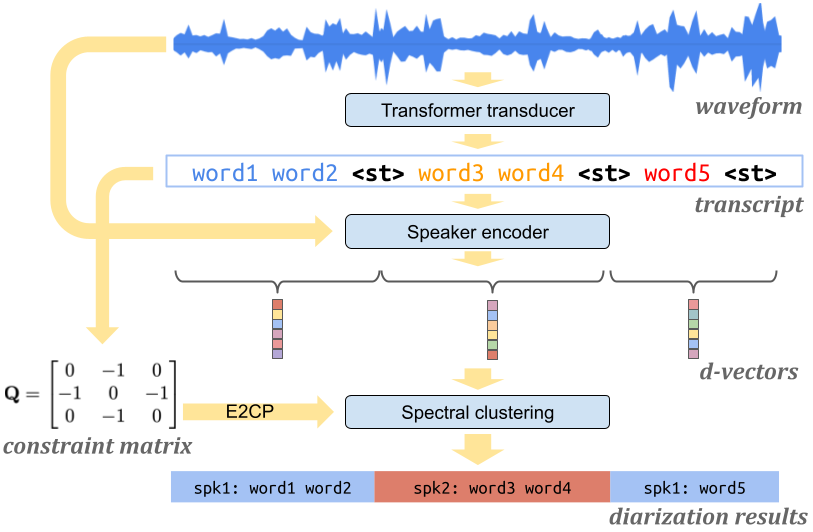原始仓库链接, 做了一些修改方便使用
- 基于谱聚类(Spectral Clustering)实现说话人分割(Speaker Diariazation)中的speaker embedding聚类
- 其他部件(VAD、Speaker Encoder)需要额外实现, 本项目中分别使用预训练好的sileroVAD和dvector
- 增加demo.ipynb用于掩饰整个pipeline的实现 (VAD -> Speaker Embedding -> Clustering)
- 增加了Makefile方便运行
- 增加了infer_rttm.py和infer_all.py将推理结果写为.rttm标签文件
docs/ spectralcluster工具包文档
spectralcluster/ 谱聚类算法
tests/ 合法性测试
others/ 其他文件
demo.ipynb 演示程序
infer_all.py 批量推理, 并将结果写为.rttm标签文件
infer_rttm.py 单次推理, 并将结果写为.rttm标签文件
详见Makefile
This is a Python re-implementation of the spectral clustering and constrained spectral clustering algorithms in these two papers:
- Speaker Diarization with LSTM
- Turn-to-Diarize: Online Speaker Diarization Constrained by Transformer Transducer Speaker Turn Detection
We recently added new functionalities to this library to include algorithms in a new paper. We updated the APIs as well.
If you depend on our old API, please use an older version of this library:
pip3 install spectralcluster==0.1.0
This is not a Google product.
This is not the original C++ implementation used by the paper.
- numpy
- scipy
- scikit-learn
Install the package by:
pip3 install spectralclusteror
python3 -m pip install spectralclusterSimply use the predict() method of class SpectralClusterer to perform
spectral clustering. The example below should be closest to the original C++
implemention used our
ICASSP 2018 paper.
from spectralcluster import configs
labels = configs.icassp2018_clusterer.predict(X)The input X is a numpy array of shape (n_samples, n_features),
and the returned labels is a numpy array of shape (n_samples,).
You can also create your own clusterer like this:
from spectralcluster import SpectralClusterer
clusterer = SpectralClusterer(
min_clusters=2,
max_clusters=7,
autotune=None,
laplacian_type=None,
refinement_options=None,
custom_dist="cosine")
labels = clusterer.predict(X)
For the complete list of parameters of SpectralClusterer, see
spectralcluster/spectral_clusterer.py.
In our ICASSP 2018 paper, we apply a sequence of refinment operations on the affinity matrix, which is critical to the performance on the speaker diarization results.
You can specify your refinment operations like this:
from spectralcluster import RefinementOptions
from spectralcluster import ThresholdType
from spectralcluster import ICASSP2018_REFINEMENT_SEQUENCE
refinement_options = RefinementOptions(
gaussian_blur_sigma=1,
p_percentile=0.95,
thresholding_soft_multiplier=0.01,
thresholding_type=ThresholdType.RowMax,
refinement_sequence=ICASSP2018_REFINEMENT_SEQUENCE)
Then you can pass the refinement_options as an argument when initializing your
SpectralClusterer object.
For the complete list of RefinementOptions, see
spectralcluster/refinement.py.
In our ICASSP 2018 paper,
we apply a refinement operation CropDiagonal on the affinity matrix, which replaces each diagonal element of the affinity matrix by the max non-diagonal value of the row. After this operation, the matrix has similar properties to a standard Laplacian matrix, and it is also less sensitive (thus more robust) to the Gaussian blur operation than a standard Laplacian matrix.
In the new version of this library, we support different types of Laplacian matrix now, including:
- None Laplacian (affinity matrix):
W - Unnormalized Laplacian:
L = D - W - Graph cut Laplacian:
L' = D^{-1/2} * L * D^{-1/2} - Random walk Laplacian:
L' = D^{-1} * L
You can specify the Laplacian matrix type with the laplacian_type argument of the SpectralClusterer class.
Note: Refinement operations are applied to the affinity matrix before computing the Laplacian matrix.
In our ICASSP 2018 paper, the K-Means is based on Cosine distance.
You can set custom_dist="cosine" when initializing your SpectralClusterer object.
You can also use other distances supported by scipy.spatial.distance, such as "euclidean" or "mahalanobis".
In our ICASSP 2018 paper,
the affinity between two embeddings is defined as (cos(x,y)+1)/2.
You can also use other affinity functions by setting affinity_function when initializing your SpectralClusterer object.
We also support auto-tuning the p_percentile parameter of the RowWiseThreshold refinement operation, which was original proposed in this paper.
You can enable this by passing in an AutoTune object to the autotune argument when initializing your SpectralClusterer object.
Example:
from spectralcluster import AutoTune
autotune = AutoTune(
p_percentile_min=0.60,
p_percentile_max=0.95,
init_search_step=0.01,
search_level=3)For the complete list of parameters of AutoTune, see
spectralcluster/autotune.py.
In the Turn-to-Diarize paper, the spectral clustering is constrained by speaker turns. We implemented two constrained spectral clustering methods:
If you pass in a ConstraintOptions object when initializing your SpectralClusterer object, you can call the predict function with a constraint_matrix.
Example usage:
from spectralcluster import constraint
ConstraintName = constraint.ConstraintName
constraint_options = constraint.ConstraintOptions(
constraint_name=ConstraintName.ConstraintPropagation,
apply_before_refinement=True,
constraint_propagation_alpha=0.6)
clusterer = spectral_clusterer.SpectralClusterer(
max_clusters=2,
refinement_options=refinement_options,
constraint_options=constraint_options,
laplacian_type=LaplacianType.GraphCut,
row_wise_renorm=True)
labels = clusterer.predict(matrix, constraint_matrix)The constraint matrix can be constructed from a speaker_turn_scores list:
from spectralcluster import constraint
constraint_matrix = constraint.ConstraintMatrix(
speaker_turn_scores, threshold=1).compute_diagonals()Our papers are cited as:
@inproceedings{wang2018speaker,
title={{Speaker Diarization with LSTM}},
author={Wang, Quan and Downey, Carlton and Wan, Li and Mansfield, Philip Andrew and Moreno, Ignacio Lopz},
booktitle={2018 IEEE International Conference on Acoustics, Speech and Signal Processing (ICASSP)},
pages={5239--5243},
year={2018},
organization={IEEE}
}
@inproceedings{xia2022turn,
title={{Turn-to-Diarize: Online Speaker Diarization Constrained by Transformer Transducer Speaker Turn Detection}},
author={Wei Xia and Han Lu and Quan Wang and Anshuman Tripathi and Yiling Huang and Ignacio Lopez Moreno and Hasim Sak},
booktitle={2022 IEEE International Conference on Acoustics, Speech and Signal Processing (ICASSP)},
year={2022},
organization={IEEE}
}
We also have fully supervised speaker diarization systems, powered by uis-rnn. Check this Google AI Blog.
To learn more about speaker diarization, here is a curated list of resources: awesome-diarization.






